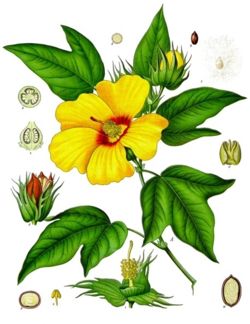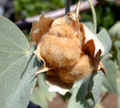Gossypium
2007 Schools Wikipedia Selection. Related subjects: Plants
| iGossypium | ||||||||||||
|---|---|---|---|---|---|---|---|---|---|---|---|---|
 Gossypium barbadense
|
||||||||||||
| Scientific classification | ||||||||||||
|
||||||||||||
|
|
||||||||||||
|
See text. |
Gossypium is a genus of 39-40 species of shrubs in the family Malvaceae, native to the tropical and subtropical regions of both the Old World and the New World. The cotton plants, sources of commercial cotton fabric, are included in this genus.
Cotton shrubs can grow up to 3 m (10 ft) high. The leaves are broad and lobed, with three to five (or rarely seven) lobes. The seeds are contained in a capsule called a boll, each seed surrounded by downy fibers called lint. Commercial species of cotton plant are G. hirsutum (U.S. and Australia), G. arboreum and G. herbaceum (Asia), and G. barbadense (Egypt). While the lint naturally occurs in colors of white, brown, and green, fears of contaminating the genetics of white cotton has led many cotton-growing locations to ban growing of colored cotton varieties.
Species of Gossypium
- Commercial cotton species
Commercial cotton fibers, used to manufacture cloth, are derived from the fruit of the cotton plant. The following species are grown commercially:
- Gossypium arboreum L. – Tree cotton, native to southern Asia, india.
- Gossypium barbadense L. – Creole cotton or Sea island cotton, native to tropical South America.
- Gossypium herbaceum L. – Levant cotton, native to southern Africa
- Gossypium hirsutum L. – Upland cotton, native to Central America, the Caribbean and southern Florida.
- Non-commercial species
- Gossypium sturtianum J.H. Willis – Sturt's Desert Rose, native to Australia.
- Gossypium thurberi Tod. – Arizona wild cotton, native to Arizona, New Mexico and northern Mexico.
- Gossypium tomentosum Nutt. ex Seem – Ma‘o or Hawaiian cotton, is a species endemic to the Hawaiian Islands. The seed hairs (lint) are short and reddish brown, unsuitable for spinning or twisting into thread.
Useful Links : http://www.cicr.gov.in Ripening commercial cotton bolls in the field]]
Cotton pests and diseases
Pests
- Boll weevil, Anthonomus grandis
- Cotton aphid, Aphis gossypii
- Cotton bollworm, Helicoverpa armigera, and native budworm Helicoverpa punctigera are caterpillars that damage cotton crops.
-
- Some other Lepidoptera larvae also feed on cotton - see list of Lepidoptera which feed on Cotton plants.
- Green mirid (Creontiades dilutus), a sucking insect
- Spider mites, Tetranychus urticae, T. ludeni and T. lambi
- Thrips, Thrips tabaci and Frankliniella schultzei
Diseases
- Alternaria leaf spot, caused by Alternaria macrospora and Alternaria alternata
- Anthracnose boll rot, caused by Colletotrichum gossypii
- Black root rot, caused by the fungus Thielaviopsis basicola
- Blight cuased by Xanthomonas campestris pv. malvacearum
- Fusarium boll rot caused by Fusarium spp.
- Phytophthora boll rot, caused by Phytophthora nicotianae var. parasitica
- Sclerotinia boll rot, caused by fungus Sclerotinia sclerotiorum
Genetically modified cotton
GM cotton was developed to reduce the heavy reliance on pesticides. GM cotton is widely used throughout the world with claims of requiring up to 80% less pesticide than ordinary cotton. The International Service for the Acquisition of Agri-Biotech Applications (ISAAA) said that worldwide GM cotton was planted on an area of 67,000 km² in 2002. This is 20% of the worldwide total area planted in cotton. The US cotton crop was 73% GM in 2003.
The initial introduction of GM cotton proved to be a commercial disaster in Australia - the yields were far lower than predicted, and the cotton plants were cross-pollinated with other varieties of cotton. However the introduction of a second variety of GM cotton led to 15% of Australian cotton being GM in 2003 with 80% of the crop being GM in 2004 when the original variety was banned.
Organic cotton
Organic cotton is cotton grown without pesticides or chemical additives to fertilizer, relying instead on methods with less ecological impact. Organic cotton is used to manufacture everything from handkerchiefs to kimono robes. Different levels of certification exist, but at a minimum, a crop must be grown in soil that has been chemical-free for at least three years.



